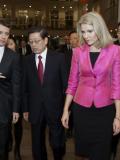A new 4th edition of the Global Green Economy Index (GGEI) calculates the green economic performance of sixty countries, as well as how global practitioners assess it. The GGEI computes these values on the following four dimensions: leadership & climate change, efficiency sectors, markets & investment, and environment & natural capital. Thirty-two underlying indicators and datasets define the GGEI performance index; a survey conducted between June and August of 2014 captures practitioner perceptions with over 1,000 responses.
Global indices like the GGEI are useful in providing one standard benchmark against which policymakers can track their absolute and relative performance in the green economy over time. By measuring each country according to the same topics and themes – while referencing universally applicable indicators and datasets – the GGEI generates a reference point to understand how one country’s green economic performance compares to another, and insight into reasons for superior or inferior results.



Last month world leaders gathered at the United Nations for a summit on global clean energy investment, while outside trade unionists, mayors, philanthropists, and student activists all rallied in a major climate march, to echo calls for divestment from fossil fuels and a new generation of investment in clean energy and good jobs. These growing calls to action raise important questions. How can we stabilize an already-changing climate in a way that promotes economic prosperity? And what levels of investment will be required to reach this urgent goal?
An important set of answers is contained in the recent study "Green Growth: A U.S. Program for Controlling Climate Change and Expanding Job Opportunities" jointly published by the University of Massachusetts Political Economy Research Institute and the Center for American Progress. This book, which I co-author with Dr. Robert Pollin, Dr. Heidi Garrett-Peltier, and Dr. James Heintz, builds on four years of research, and the findings are cause for both great hope and grave concern.


